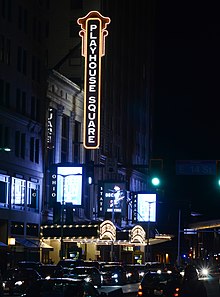Playhouse Square
The Playhouse Square building ensemble in Cleveland (Ohio) is a complex of theater buildings from the 1920s, which, threatened with immediate demolition, was rescued in the 1970s by a citizens' initiative . Today, according to the Foundation, which acts as the sponsoring company, it is the world's largest project of theater restoration and is the second largest cultural center in the USA, after Lincoln Center in New York, dedicated to the performing arts. It currently comprises eight venues, including five large theaters, and is visited by more than a million people every year.
history
The five theaters (Ohio, Palace, State, Allen and Hanna) were built almost simultaneously at the beginning of the prosperity period of the 1920s.
On February 5, 1921, the State Theater opened as a film and vaudeville stage (it closed on February 2, 1969 and reopened on June 9, 1984). The four large wall paintings by James Daugherty (1890–1974) are particularly noteworthy .
The Ohio Theater opened on February 14, 1921, closed on the same day as the State Theater, and reopened on July 9, 1982. Much of its original equipment was lost in a fire in 1964. The Ohio was dedicated to spoken theater. Both the State and Ohio Theaters were designed by specialist theater and cinema architect Thomas W. Lamb .
The Hanna Theater was opened as a spoken theater on March 28, 1921, closed in 1988 and reopened in September 1997. The coffered ceiling is remarkable here.
The Allen Theater opened its doors on April 1, 1921 as the Film Palace . Its side boxes are purely decorative. It closed on May 7, 1968, reopened after a series of restorations in 1984, 1988 and most recently on September 16, 2011. Today it is the home of the Cleveland Play House .
The Palace Theater was dedicated to vaudeville, and from 1926 to film. It opened on November 6, 1922, closed on July 20, 1969. It was able to reopen on April 30, 1988.
The elaborate design of these theaters in the style of various variants of neoclassicism included the use of Carrara marble, precious woods, wall paintings, stucco and gilding. The rotunda of the Allen Theater, for example, was modeled on Raphael's Villa Madama in Rome, the Palace had a large blue Sèvres vase and the Grand Lobby of the Ohio with its Corinthian columns was modeled on Fontainebleau Castle .
Suburbanization and deindustrialization after 1945 as well as the rise of television had a negative impact on this theater center on western Euclid Avenue . The steel city of Cleveland also shrank from 800,000 residents in 1920 to 573,000 in 1980. After 1970, most of these theaters were in immediate danger of being demolished after years of vacancy. Vandalism and structural neglect seemed to result in final destruction.
Under the leadership of the teacher Ray Shepardson, however, a citizens' initiative was formed that did not want to stand idly by this decline. <Ibid, p. 7) The group "Playhouse Square Association" acted as a lobby and was recognized in 1970 as a non-profit organization. The imminent demolition of two theaters (Allen and State) mobilized a broad citizens' movement in 1972: a series of performances of " Jacques Brel Is Alive and Well and Living in Paris " proved to be a sensational success at the State Theater in 1973-75.
The monument protection activists managed to raise $ 40 million in public-private partnership . In the end, it was possible to save all five theaters, including all that was endangered until 1993.
The successful revitalization of the theater district is considered "one of the top 10 successes in Cleveland history."
Individual evidence
- ↑ See Patricia M. Mote, pp. 18ff
literature
- Patricia M. Mote: Cleveland's Playhouse Square , Arcadia Publishing 2006, ISBN 0-7385-4013-7 .
Web links
Coordinates: 41 ° 30 ′ 3 " N , 81 ° 40 ′ 52" W.



